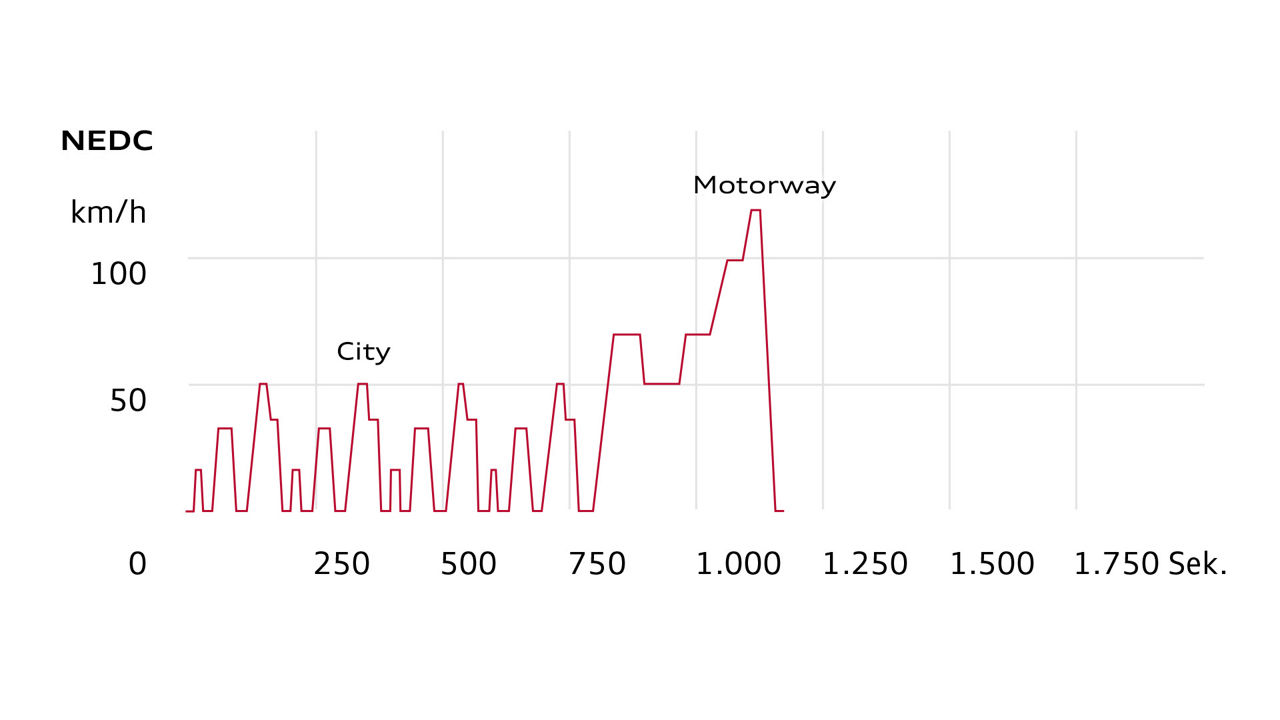Closer to real consumption: WLTP replacing New European Driving Cycle (NEDC).
From 1 September 2017, fuel consumption figures for new cars entering the market have been determined using a new procedure, the WLTP. The WLTP will then be required of all new vehicle registrations from 1 September 2018. WLTP stands for Worldwide Harmonized Light-Duty Vehicles Test Procedure and is used to determine the fuel consumption and exhaust emissions of vehicles. Find out what that means for you and your Audi here.
NEDC vs. WLTP

NEDC
NEDC

WLTP
WLTP
NEDC
- The temperature in the test chamber was 20-30°C
- The distance was about 11 km.
- The cycle lasted about 20 minutes.
- The cycle consisted of two phases:
- approx. 13 minutes of simulated city driving
- approx. 7 minutes of simulated cross-country driving - The average speed is about 33 km/h.
- The vehicle was not moving 25% of the time.
- The highest speed tested was 120 km/h.
- The points where gears were shifted on models with manual transmission were precisely specified.
- Special equipment and air conditioning were not taken into account.
WLTP
- The temperature in the test chamber is 23°C
- The distance is about 23 km.
- The cycle lasts about 30 minutes.
- It consists of four phases (low, medium, high, extra-high).
- The average speed is about 47 km/h.
- The vehicle was not moving 13% of the time.
- The highest speed tested was over 130 km/h.
- The gear shift points are calculated individually for each vehicle in advance.
- Vehicle weight and additional equipment are included in the evaluation.
Objectives of the new procedure.
The WLTP procedure redefines the test parameters for determining fuel consumption and exhaust emissions. The advantages at a glance:
Questions and Answers
<div class="legacy nm-content-paragraph " data-module="content-paragraph"> <div class="nm-content-paragraph__text-container"> <div class="audi-copy-m nm-content-paragraph__text">In order to measure how much fuel a car consumes and whether it complies with applicable limits on vehicle emissions, standardised test procedures are prescribed. The framework conditions for testing and handling test results are defined by EU law. This ensures that the same framework conditions are used by all car manufacturers and other actors for transparent comparability. The test procedure measures the CO₂ and consumption values and exhaust emissions of a vehicle. For a new passenger car or light commercial vehicle model to be approved, the new "Worldwide Harmonized Light-Duty Vehicles Test Procedure" (WLTP) test procedure will gradually be applied throughout the EU as of 1 September 2017, replacing the previous NEDC (New European Driving Cycle). Approvals for new passenger car models or new engine/transmission options in Europe will only be made based on the WLTP results. From 1 September 2018, all vehicles when registered for the first time will have to be WLTP-certified.</div> </div> </div>
<div class="legacy nm-content-paragraph " data-module="content-paragraph"> <div class="nm-content-paragraph__text-container"> <div class="audi-copy-m nm-content-paragraph__text">WLTP is being implemented in the 28 EU Member States as well as Norway, Iceland, Switzerland, Liechtenstein, Turkey, and Israel. It is also being used in a modified form in Japan and to test emissions in China. India and South Korea plan to introduce it at a later date.</div> </div> </div>
<div class="legacy nm-content-paragraph " data-module="content-paragraph"> <div class="nm-content-paragraph__text-container"> <div class="audi-copy-m nm-content-paragraph__text">No. The switch to WLTP will not mean any changes for vehicles already registered. In general, there are no CO₂ emissions and fuel consumption parameters in place for vehicles that were approved according to the previous procedure (NEDC). For these vehicles, the NEDC parameters remain relevant.</div> </div> </div>
<div class="legacy nm-content-paragraph " data-module="content-paragraph"> <div class="nm-content-paragraph__text-container"> <div class="audi-copy-m nm-content-paragraph__text">The EU Commission has recommended a uniform conversion of NEDC values to WLTP CO₂ emission and fuel consumption figures for disclosure to consumers by 1 January 2019. However, the binding rules on consumer disclosures are set at the national level. This may result in differences across markets.</div> </div> </div>
<div class="legacy nm-content-paragraph " data-module="content-paragraph"> <div class="nm-content-paragraph__text-container"> <div class="audi-copy-m nm-content-paragraph__text">WLTP has been mandatory for the approval of new models since September 2017. In Germany, the switch to tax law will take effect on 01.09.2018. A deadline for disclosing the revised values has not yet been set. The NEDC therefore remains legally binding for the labelling and taxation of vehicles. The proposal of the EU Commission is a uniform transition of all new vehicles in consumer disclosures and taxation by 1.1.2019, in order to avoid unnecessary customer confusion with both NEDC and WLTP values being listed on new vehicles. In the transitional period from September 2017 to probably January 2019, the voluntary disclosure of the WLTP values to consumers is permitted. However, it must be clearly marked as an additional indicator of consumption. For the time being, the NEDC values remain binding for showroom labels and determining the energy efficiency label. The same applies to the calculation of vehicle taxes (in countries with a emissions-based tax component). However, taxation is part of national legislation and will be regulated in each country. Different approaches and timings are likely.</div> </div> </div>
<div class="legacy nm-content-paragraph " data-module="content-paragraph"> <div class="nm-content-paragraph__text-container"> <div class="audi-copy-m nm-content-paragraph__text">Even today in the NEDC, the results of the measurements from the test procedure are recorded in the certificate of conformity (CoC) enclosed with each vehicle. This certificate is the prerequisite for the authorities to issue a vehicle registration document with which the owner can later register the vehicle. For vehicles that have been tested according to WLTP, there will be two different CO₂ emission and fuel consumption values listed on the CoC: the WLTP values and the calculated NEDC values. The latter form the basis for the country-specific conversion of fuel consumption labelling and tax calculation until that country switches entirely over to WLTP.</div> </div> </div>
<div class="legacy nm-content-paragraph " data-module="content-paragraph"> <div class="nm-content-paragraph__text-container"> <div class="audi-copy-m nm-content-paragraph__text">RDE stands for Real Driving Emissions and refers to an exhaust gas measurement that takes place on the road and not in a laboratory under standardized as is the case with the WLTP. The key difference: in the RDE test, the exhaust gas components NOx (nitrogen oxides) and particulates (particulate matter) are tested using real-time road driving using mobile emission measurement technology (PEMS), but due to the large dispersion in road measurements, fuel consumption and CO2 emissions are not measured. In conjunction with the introduction of WLTP, manufacturers must limit their vehicles' NOx and particulate emissions in real road traffic. While the particulate count limit is the same as for the WLTP, a conformity factor of 2.1 is used for the nitrogen oxides in RDE Stage 1. With a NOx limit of 80 mg/km for a Euro 6 diesel car, this corresponds to a maximum allowable emissions of 168 mg/km under RDE conditions. In RDE Stage 2, the conformity factor for NOx has been lowered to 1.0 (plus a margin for measurement tolerance).</div> </div> </div>




